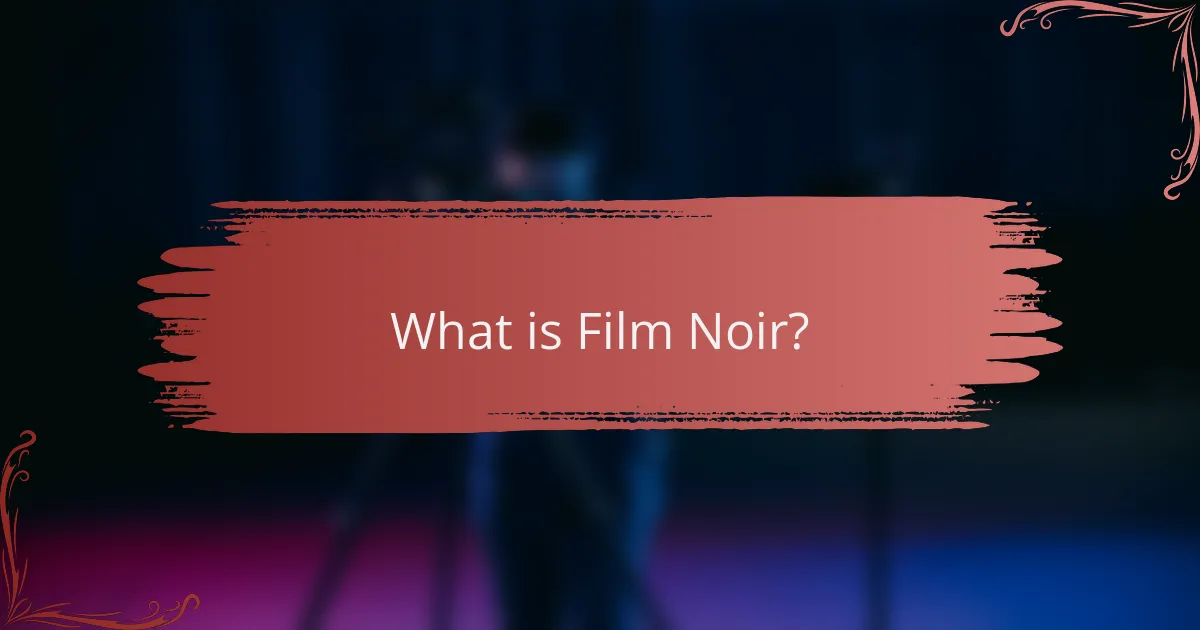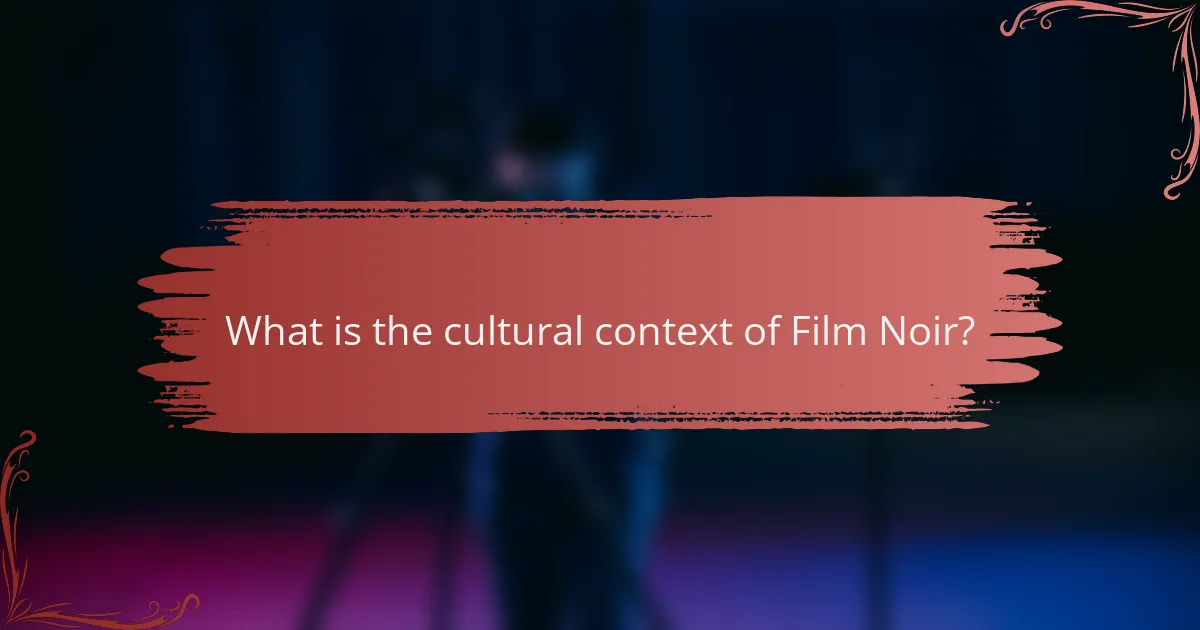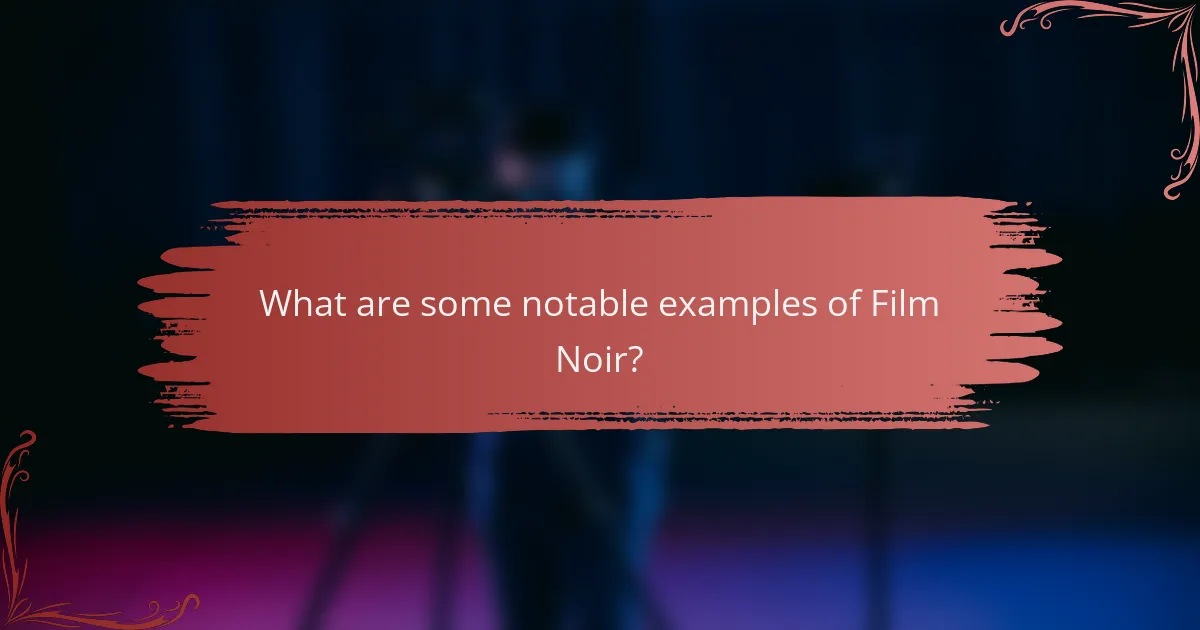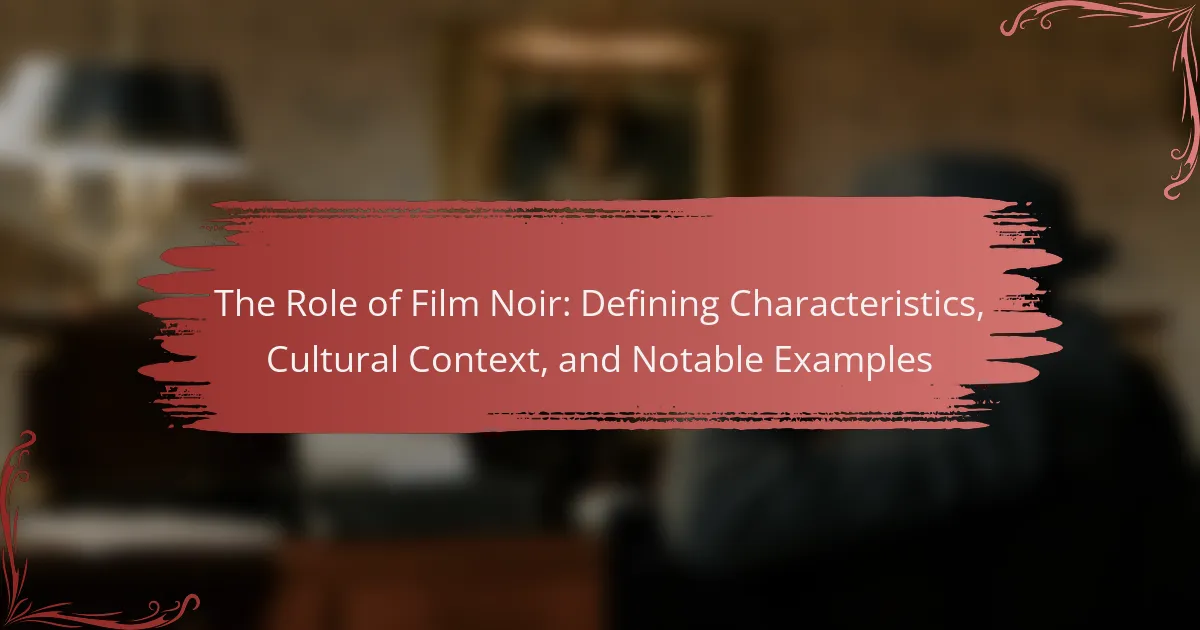Film Noir is a cinematic genre that emerged in the early 1940s, characterized by its dark aesthetic and themes of moral ambiguity. This genre often explores crime and existential issues through complex characters, utilizing visual elements such as low-key lighting and unusual camera angles. It reflects the societal anxieties of post-World War II America, addressing themes of disillusionment and urban corruption. Notable films in this genre include “Double Indemnity,” “The Maltese Falcon,” and “Sunset Boulevard,” each exemplifying the defining characteristics of Film Noir and its influence on future filmmaking.

What is Film Noir?
Film Noir is a cinematic genre characterized by its dark, moody aesthetic and moral ambiguity. It emerged in the early 1940s and gained prominence in American cinema. Film Noir often features crime, existential themes, and complex characters. The visual style includes low-key lighting and unusual camera angles. Common elements include femme fatales and hard-boiled detectives. The genre reflects post-World War II societal anxieties. Notable examples include “Double Indemnity” and “The Maltese Falcon.” Film Noir has influenced many filmmakers and genres since its inception.
How did Film Noir emerge as a genre?
Film Noir emerged as a genre in the early 1940s. It developed primarily in the United States during and after World War II. The genre is characterized by its dark themes and moral ambiguity. Influences include German Expressionism and hardboiled crime fiction. Film Noir often features cynical protagonists and femme fatales. The term “Film Noir” was coined by French critics in the 1940s. Classic examples include “The Maltese Falcon” (1941) and “Double Indemnity” (1944). These films reflect the anxieties of post-war society.
What historical events influenced the development of Film Noir?
The development of Film Noir was influenced by several historical events. The aftermath of World War II shaped the themes of disillusionment and moral ambiguity in cinema. The Great Depression led to a focus on crime and survival in storytelling. The rise of fascism and the Holocaust created a backdrop of paranoia and existential dread. Additionally, the noir genre was influenced by the hard-boiled detective fiction of the 1920s and 1930s. The changing social dynamics in post-war America further contributed to the genre’s exploration of gender roles and identity. These events collectively shaped the aesthetic and thematic elements of Film Noir.
How does Film Noir differ from other film genres?
Film Noir is distinct from other film genres primarily due to its thematic focus and stylistic elements. It often explores moral ambiguity, crime, and existential despair. The visual style typically features high-contrast lighting and shadowy cinematography, creating a sense of dread. Characteristically, protagonists in Film Noir are often antiheroes or flawed individuals. The narrative structure frequently employs non-linear storytelling and voice-over narration. Additionally, Film Noir is marked by its use of femme fatales, who embody danger and seduction. Historically, this genre emerged in the 1940s and 1950s, influenced by German Expressionism. These attributes differentiate Film Noir from more conventional genres like romance or comedy, which typically present clearer moral lines and resolutions.
What are the defining characteristics of Film Noir?
Film Noir is characterized by its dark themes, moral ambiguity, and visual style. The narrative often features a cynical protagonist facing a corrupt world. Characters typically include femme fatales and hard-boiled detectives. The visual style employs stark lighting contrasts and deep shadows. These elements create a sense of tension and unease. Film Noir emerged in the 1940s and 1950s, reflecting post-war disillusionment. The genre draws inspiration from German Expressionism and hardboiled crime fiction. Classic examples include “Double Indemnity” and “The Maltese Falcon.”
What visual styles are commonly associated with Film Noir?
Film Noir is characterized by its distinct visual styles. Common styles include high-contrast lighting, known as chiaroscuro. This technique creates dramatic shadows and emphasizes the moral ambiguity of characters. Additionally, low-angle shots are frequently used to enhance tension and portray characters as powerful or threatening.
Another hallmark is the use of urban settings, often depicted as dark and oppressive environments. These settings reflect the themes of isolation and despair prevalent in the genre. Furthermore, Film Noir often employs a muted color palette, particularly in black and white films, to evoke a sense of bleakness.
The inclusion of Dutch angles is also notable, creating a disorienting effect that mirrors the psychological states of characters. Overall, these visual styles work together to establish the mood and themes central to Film Noir narratives.
How do themes of morality and existentialism manifest in Film Noir?
Themes of morality and existentialism manifest in Film Noir through complex characters and morally ambiguous situations. Protagonists often grapple with ethical dilemmas, reflecting a struggle between right and wrong. This internal conflict showcases the existential crisis faced by characters who question their purpose and the nature of their actions. The narrative frequently presents a deterministic view of life, suggesting that choices are influenced by external circumstances rather than free will. Films like “Double Indemnity” and “The Maltese Falcon” illustrate these themes, where characters’ decisions lead to inevitable consequences. The bleak settings and cynical dialogue further emphasize the moral ambiguity and existential despair present in the genre.
What role do characters play in Film Noir narratives?
Characters in Film Noir narratives serve as complex embodiments of moral ambiguity and existential despair. They often find themselves trapped in a world of crime and corruption. Protagonists typically exhibit flawed traits, such as cynicism and desperation. Antagonists often represent the darker aspects of human nature, such as greed and betrayal. The femme fatale is a recurring character type, symbolizing seduction and danger. This character often leads the male protagonist into perilous situations. The narrative structure frequently revolves around character-driven conflicts and psychological tension. Their interactions reveal the themes of trust, betrayal, and the search for identity.
What archetypes are prevalent in Film Noir films?
Prevalent archetypes in Film Noir films include the hard-boiled detective, the femme fatale, and the morally ambiguous protagonist. The hard-boiled detective is often a cynical and tough character who navigates a corrupt world. The femme fatale typically embodies seduction and danger, leading men to their downfall. The morally ambiguous protagonist often grapples with ethical dilemmas, showcasing the complexities of human nature. These archetypes reflect the themes of betrayal, moral ambiguity, and existential despair commonly found in Film Noir. The use of these characters contributes to the genre’s distinctive narrative style and tone.
How do character relationships drive the plot in Film Noir?
Character relationships drive the plot in Film Noir by creating tension and conflict. These relationships often involve betrayal, deception, and moral ambiguity. The protagonist typically interacts with complex characters who have hidden motives. This dynamic propels the narrative forward, leading to unexpected twists. For example, the femme fatale often manipulates the male lead, complicating his choices. Such relationships highlight themes of trust and betrayal, which are central to the genre. The interplay between characters reveals their vulnerabilities and desires, influencing their actions. In Film Noir, character relationships are crucial for establishing the dark, suspenseful atmosphere that defines the genre.

What is the cultural context of Film Noir?
Film Noir emerged as a cinematic style during the 1940s and 1950s. It reflects post-World War II American society. The genre captures themes of disillusionment and moral ambiguity. It often portrays urban settings filled with crime and corruption. The cultural context includes a reaction to the socio-political climate of the time. Many films address the anxieties of war and the changing American identity. Influences from German Expressionism are evident in its visual style. The use of shadows and low-key lighting enhances the mood of despair and tension. This genre also reflects the evolving roles of women and the complexities of relationships in a changing society.
How did societal attitudes influence Film Noir’s themes?
Societal attitudes significantly influenced Film Noir’s themes by reflecting post-war disillusionment and moral ambiguity. After World War II, audiences experienced a loss of faith in traditional values. This led to darker narratives that explored themes of betrayal, existentialism, and cynicism. The portrayal of anti-heroes became prevalent, showcasing flawed characters grappling with their own morality. Additionally, societal views on gender roles shifted, leading to complex female characters often depicted as femme fatales. The economic struggles of the era also contributed to themes of desperation and survival. Film Noir served as a mirror to the anxieties and uncertainties of contemporary society, encapsulating the zeitgeist of the time.
What impact did World War II have on the Film Noir genre?
World War II significantly influenced the Film Noir genre. The war’s aftermath created a climate of disillusionment and moral ambiguity. This context shaped the themes of Film Noir, emphasizing cynicism and existential despair. Many films depicted flawed characters facing moral dilemmas. The visual style also evolved, featuring darker cinematography and urban settings. Additionally, the war led to a rise in crime rates, which filmmakers reflected in their narratives. Social upheaval and trauma from the war contributed to the genre’s pervasive sense of paranoia. Overall, World War II was a catalyst for the thematic and stylistic development of Film Noir.
How does Film Noir reflect the anxieties of its time?
Film Noir reflects the anxieties of its time through its themes of moral ambiguity and existential dread. The genre emerged in the 1940s and 1950s, a period marked by post-war disillusionment. It portrays a sense of uncertainty and paranoia prevalent in society during the Cold War. Characters often face betrayal and corruption, mirroring the public’s fear of authority and trust issues. The visual style, characterized by shadows and stark contrasts, evokes a bleak outlook on life. This aesthetic reinforces the emotional turmoil and instability of the era. Films like “Double Indemnity” and “The Maltese Falcon” exemplify these themes. They depict flawed protagonists navigating a treacherous world, reflecting the collective anxiety of their time.
What is the significance of Film Noir in American cinema?
Film Noir is significant in American cinema as it represents a distinct genre characterized by its dark themes and moral ambiguity. It emerged in the 1940s and 1950s, reflecting post-war disillusionment. The genre often features anti-heroes, femme fatales, and a pessimistic worldview. Notable films include “Double Indemnity” and “The Maltese Falcon.” Film Noir also influenced visual style, employing low-key lighting and unusual camera angles. Its impact extended beyond film, influencing literature and television. The genre remains a critical reference point in discussions of American cultural identity and storytelling.
How has Film Noir influenced modern filmmaking?
Film Noir has significantly influenced modern filmmaking through its distinctive visual style and narrative techniques. The use of chiaroscuro lighting and urban settings creates a moody atmosphere that is often replicated today. Many contemporary films adopt the moral ambiguity and complex characters typical of Film Noir. This genre emphasizes themes of existentialism and disillusionment, which resonate in modern storytelling.
Directors like Christopher Nolan and David Fincher have cited Film Noir as an inspiration for their work. The narrative structure often involves unreliable narrators, a hallmark of Noir that persists in modern cinema. Additionally, the femme fatale archetype continues to appear in various films, showcasing the lasting impact of Film Noir on character development.
Overall, Film Noir’s legacy is evident in the stylistic choices and thematic depth of many films produced today.
What legacy has Film Noir left on contemporary genres?
Film Noir has profoundly influenced contemporary genres, particularly crime, thriller, and neo-noir. Its stylistic elements, such as chiaroscuro lighting and urban settings, are prevalent in modern films. The moral ambiguity and complex characters introduced in Film Noir are now common in contemporary storytelling. Themes of existential despair and paranoia resonate in today’s psychological thrillers. The narrative techniques, including non-linear storytelling and unreliable narrators, have also been adopted widely. For example, films like “Chinatown” and “Seven” reflect Film Noir’s lasting impact. Contemporary series like “True Detective” echo its dark themes and character depth. Overall, Film Noir’s legacy continues to shape the cinematic landscape.

What are some notable examples of Film Noir?
Notable examples of Film Noir include “Double Indemnity,” “The Maltese Falcon,” and “Sunset Boulevard.” “Double Indemnity,” released in 1944, is a hallmark of the genre that showcases a femme fatale and a complex murder plot. “The Maltese Falcon,” released in 1941, features a private detective embroiled in a quest for a priceless statuette. “Sunset Boulevard,” released in 1950, explores themes of fame and obsession through the story of a faded silent film star. These films exemplify the stylistic and thematic elements characteristic of Film Noir, including moral ambiguity and dark visual aesthetics.
Which films are considered classics of the Film Noir genre?
Classics of the Film Noir genre include “The Maltese Falcon,” “Double Indemnity,” and “Sunset Boulevard.” “The Maltese Falcon,” released in 1941, is often regarded as the first major film noir. It features a complex plot and morally ambiguous characters. “Double Indemnity,” from 1944, showcases themes of betrayal and greed, becoming a hallmark of the genre. “Sunset Boulevard,” released in 1950, provides a critical look at Hollywood’s dark side. Other notable films include “Laura,” “The Big Sleep,” and “Touch of Evil.” Each film exemplifies key noir elements such as crime, femme fatales, and a cynical worldview.
What makes ‘Double Indemnity’ a quintessential Film Noir film?
‘Double Indemnity’ is a quintessential Film Noir film due to its dark themes, moral ambiguity, and stylistic elements. The narrative centers on betrayal, greed, and murder. It features a femme fatale, a hallmark of the genre, who manipulates the male protagonist. The film employs chiaroscuro lighting, creating stark contrasts that enhance its sinister mood. It also utilizes voice-over narration, a common technique in Film Noir, to convey inner thoughts and motivations. Released in 1944, ‘Double Indemnity’ set a standard for the genre with its complex characters and plot twists. The film’s influence is evident in later works, solidifying its status as a defining example of Film Noir.
How does ‘The Maltese Falcon’ exemplify Film Noir characteristics?
‘The Maltese Falcon’ exemplifies Film Noir characteristics through its dark themes, morally ambiguous characters, and stylistic elements. The film features a hard-boiled detective, Sam Spade, who navigates a treacherous world filled with deception. The narrative is driven by a quest for a valuable artifact, the Maltese Falcon, which symbolizes greed and betrayal.
Visually, the film employs low-key lighting and deep shadows to create a sense of unease. The use of urban settings reflects the gritty reality of post-war America. Additionally, the dialogue is sharp and filled with cynicism, characteristic of Film Noir. The characters often face moral dilemmas, highlighting themes of trust and betrayal.
The film’s complex plot structure, with twists and turns, keeps the audience engaged while showcasing the fatalistic outlook typical of the genre. Overall, ‘The Maltese Falcon’ is a quintessential example of Film Noir, embodying its defining traits through storytelling, visual style, and character development.
What are the key takeaways from studying Film Noir?
Key takeaways from studying Film Noir include understanding its defining characteristics, themes, and cultural significance. Film Noir features a distinctive visual style characterized by low-key lighting and urban settings. Common themes include moral ambiguity, existential despair, and the complexities of human nature. The genre often portrays flawed protagonists and femme fatales, highlighting the darker aspects of society. Studying Film Noir reveals its influence on modern cinema and its reflection of post-war anxieties. Additionally, it showcases the evolution of storytelling techniques and character development in film history. The genre’s impact on visual aesthetics and narrative structure remains significant in contemporary filmmaking.
What lessons can filmmakers learn from Film Noir’s storytelling techniques?
Filmmakers can learn several valuable lessons from Film Noir’s storytelling techniques. First, the use of moral ambiguity creates complex characters. This complexity engages audiences by challenging their perceptions of good and evil. Second, Film Noir employs a distinctive visual style. High-contrast lighting and unusual angles enhance the mood and atmosphere. Third, the narrative structure often includes non-linear storytelling. This technique keeps viewers intrigued and encourages active engagement with the plot. Fourth, strong dialogue is a hallmark of Film Noir. Witty, sharp exchanges add depth to character interactions. Fifth, themes of alienation and existentialism resonate throughout the genre. These themes reflect societal anxieties and can be relevant in contemporary storytelling. Lastly, the use of femme fatales introduces powerful female characters. This challenges traditional gender roles and adds layers to the narrative. Together, these elements can help filmmakers create compelling, thought-provoking stories.
How can audiences appreciate the nuances of Film Noir films?
Audiences can appreciate the nuances of Film Noir films by understanding their defining characteristics. Film Noir is known for its stylistic elements, including low-key lighting and unconventional narrative structures. Recognizing themes of moral ambiguity and existential despair enhances viewer engagement. Audiences should also pay attention to character archetypes, such as the femme fatale and the anti-hero. Analyzing the use of voice-over narration and flashbacks reveals deeper storytelling techniques. Historical context, particularly post-World War II disillusionment, informs the genre’s tone and themes. Familiarity with notable examples, like “Double Indemnity” and “The Maltese Falcon,” provides insight into the genre’s evolution. Engaging with critical analyses and scholarly articles further enriches understanding of Film Noir’s complexities.
Film Noir is a cinematic genre that emerged in the early 1940s, characterized by its dark aesthetic, moral ambiguity, and complex characters. This article explores the defining characteristics of Film Noir, including its visual style, thematic elements, and archetypal characters such as femme fatales and hard-boiled detectives. It also examines the cultural context that influenced its development, particularly post-World War II societal anxieties, and highlights notable examples like “Double Indemnity” and “The Maltese Falcon.” By analyzing the impact of historical events and societal attitudes, the article underscores the significance of Film Noir in American cinema and its lasting legacy on modern filmmaking.
